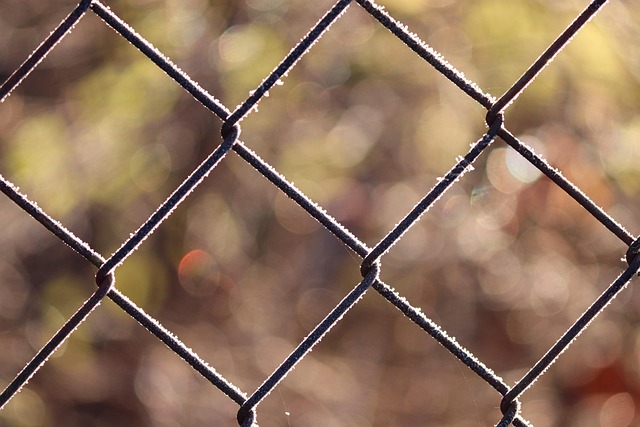Fences serve as both functional and aesthetic elements in our outdoor spaces, and proper care ensures their longevity. This article guides you through the process of fence staining and sealing, offering insights into the benefits and types of stains, choosing the right product for your wood fence, preparing for a smooth application, and maintaining color and protection over time. By following these steps, you’ll extend the life of your wooden fences while enhancing their beauty.
- Understanding Fence Staining: Benefits and Types
- Choosing the Right Stain for Your Wood Fence
- Preparation: Ensuring a Smooth Staining Process
- Step-by-Step Guide to Fence Staining
- Sealing Techniques for Long-Lasting Protection
- Maintenance Tips for Lasting Color and Shield
Understanding Fence Staining: Benefits and Types
Fence staining is an excellent way to enhance the appearance and protect your wooden fences. It involves applying a colored sealant to the fence’s surface, offering both aesthetic and functional advantages. The primary benefit is its ability to transform an ordinary fence into a visually appealing feature that complements your outdoor space. With various stain options available, you can choose from a range of colors to match your preferred style or blend seamlessly with surrounding landscapes.
There are two primary types of fence staining: solid stains and semi-transparent stains. Solid stains provide complete color coverage, effectively hiding any existing fade or damage. They are ideal for restoring older fences or achieving a bold, new look. Semi-transparent stains, on the other hand, allow some wood grain to show through while still adding color and protection. This option is perfect for maintaining a natural wood appearance while offering extra durability.
Choosing the Right Stain for Your Wood Fence
When it comes to choosing the right stain for your wooden fence, understanding your wood type and desired outcome is key. Different types of wood absorb stains differently, so selecting a product suited to your specific wood species is essential. For instance, cedar and redwood naturally resist rot and decay, making them less porous and requiring water-based or oil-based stains that penetrate rather than soak in. In contrast, pressure-treated wood, often used for budget-friendly fences, may need a stain with better blocking properties to protect against fading and peeling.
Consider the overall look you’re aiming for—a subtle enhancement or a bold transformation. Light stains highlight the natural grain of the wood while providing some protection, while dark stains create a dramatic contrast and offer more robust coverage. Always test a small area first to ensure the stain color meets your expectations and check the manufacturer’s instructions for application and drying times.
Preparation: Ensuring a Smooth Staining Process
Before beginning the staining process, proper preparation is key to achieving a smooth and long-lasting finish. Start by inspecting your wooden fence for any damaged or rotten sections. Repair or replace these areas as needed, ensuring the fence is in good condition. Clean the fence thoroughly using a pressure washer or a stiff brush to remove dirt, dust, mildew, and any existing stains. This step is crucial as it allows the new stain to adhere properly.
Additionally, sand the fence lightly to roughen the surface slightly, creating a better bond for the stain. Remove all debris and dust from the fence after sanding. By taking these preparatory steps, you’ll create an ideal surface for staining, ensuring even coverage and a more durable result.
Step-by-Step Guide to Fence Staining
To achieve a vibrant, lasting finish for your wooden fence, follow this step-by-step guide. Begin by cleaning the fence thoroughly to remove any dirt, dust, or debris using a pressure washer or brush. This ensures the stain adheres properly. Next, repair any damaged areas with wood putty and allow it to dry completely. Sand the fence gently to create a smooth surface, wiping away any residual dust afterward.
Choose a high-quality exterior fence stain suitable for your climate conditions. Apply the stain using a brush or roller, following the manufacturer’s instructions for recommended coverage. Start from the top and work your way down, overlapping each section slightly. Allow the first coat to dry as per the product guidelines before adding a second coat for enhanced protection and color intensity.
Sealing Techniques for Long-Lasting Protection
When it comes to sealing your wooden fence, there are various techniques to choose from, each offering different levels of protection and aesthetics. One common method is applying a clear sealant, which creates a protective barrier against water, UV rays, and minor stains. This option preserves the natural look of the wood, allowing its beauty to enhance over time. Alternatively, you can opt for stained sealers that not only protect but also add colour and tone to your fence, providing a more dramatic and customised appearance.
For extra durability, some professionals recommend using semi-transparent or solid colour paints as a sealing technique. These offer superior protection against fading, cracking, and peeling, ensuring your fence remains vibrant for years. This method is ideal for those seeking both aesthetic appeal and long-lasting results, making it a popular choice for homeowners looking to invest in their outdoor spaces.
Maintenance Tips for Lasting Color and Shield
Regular maintenance is key to keeping your fence looking its best and ensuring the stain stays on for longer. After initial staining, it’s important to seal the wood annually to protect against water damage and UV rays from the sun. This simple step will go a long way in preserving the vibrant color and texture of your fence.
In between seals, keep an eye out for any damaged or peeling sections and repair them promptly. Using a brush to touch up these areas can help maintain a uniform appearance. Additionally, cleaning your fence regularly with a soft brush or cloth will remove dirt, mildew, and other debris that can dull the stain’s finish.
